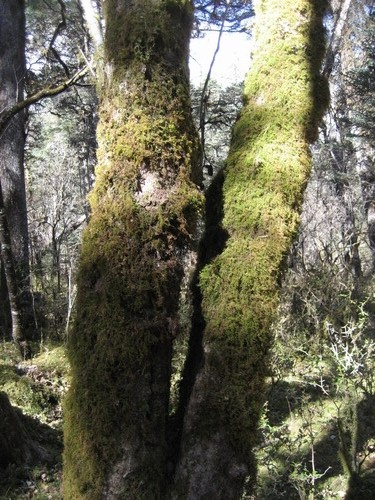Bryophytes are one of the earliest and most diversified groups of land plant. According to literature, Yunnan province harbors an estimated 70% (1500 spp.) of the Chinese bryophyte flora. However, few studies have been conducted to understand the species composition and distribution patterns of epiphytic bryophytes along altitudinal gradients in Yunnan Province. Prof. LIU Wenyao and his team of Xishuangbanna Tropical Botanical Garden (XTBG) investigated bryophytes on tree boles in three protected forested areas in sub-montane (Mengla transect: 800–1400 m), montane (Zhenyuan transect: 2000–2600 m) and sub-alpine (Lijiang transect: 3200–3800 m) regions in Yunnan, SW China. They aimed to determine species composition and distribution patterns of epiphytic bryophytes of the three poorly-studied protected forest areas; to understand similarity and diversity patterns of epiphytic bryophyte communities in different forests and along altitudinal gradients. They further aimed to assess the major drivers and the conservation implications of the distribution patterns.
The researchers established sixty 20 m × 20 m sampling plots, five at each of 12 altitudes at 200-m intervals along the transects. They investigated the species composition and cover of bryophytes from 594 subplots (each 400 cm2) on large tree boles of these plots. The differences in species diversity among different transects were tested by adopting one-way ANOVAs. Multi-dimensional scaling in two dimension ordinations was conducted to assess similarity of bryophyte communities among study transects and altitudes. Canonical correspondence analysis was applied to relate species composition to selected environmental variables.
In the study, 226 epiphytic bryophyte species belonging to 101 genera and 46 families were recorded. The Mengla transect was dominated by smooth mat bryophytes at all altitudes, except 800 m, which was dominated by fan life forms. Fan was also the most common life form in the Zhenyuan transect, while turf bryophytes dominated the Lijiang transect. The bryophyte fauna of the Zhenyuan and Lijiang transects was most similar, whereas fauna of the Mengla and Lijiang transects were least similar. Epiphytic bryophytes exhibited a hump-shaped species richness pattern with increasing altitude. At about 2600 meters above sea level, both the species richness and moisture levels reached the highest.
This study is the first assessment of species composition and diversity patterns of epiphytic bryophytes on a geographical scale in SW China, and provides fundamental data allowing an evaluation of biodiversity in Yunnan Province. The researchers determined that almost all of the epiphytic bryophyte species (99%) were considered locally rare. The researchers concluded that conserving these forests and the bryoflora is very important. Furthermore, the regional pattern of lower epiphytic bryophyte diversity in warmer, drier areas shown in this study reveals how emerging climate change threatens Yunnan's epiphytic bryophytes.
The study entitled “Bole bryophyte diversity and distribution patterns along three altitudinal gradients in Yunnan, China” has been published online in Journal of Vegetation Science.

Rich bryophytes on tree boles (Image by SONG Liang)

